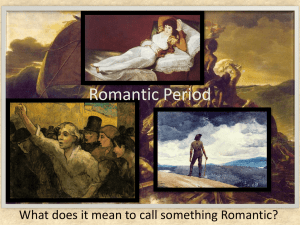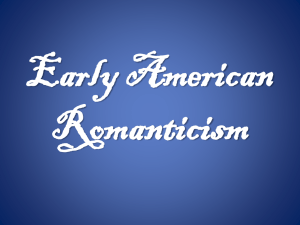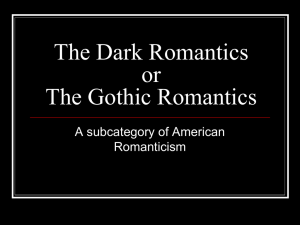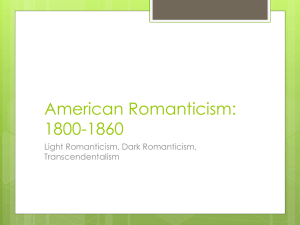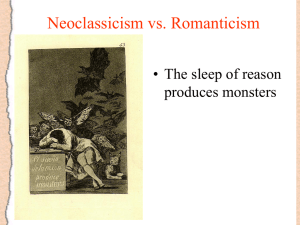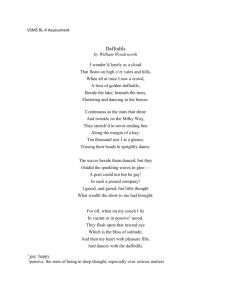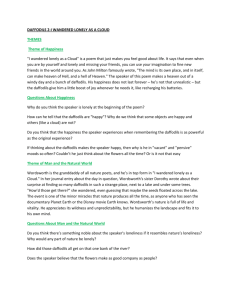File - Room 24 English
advertisement
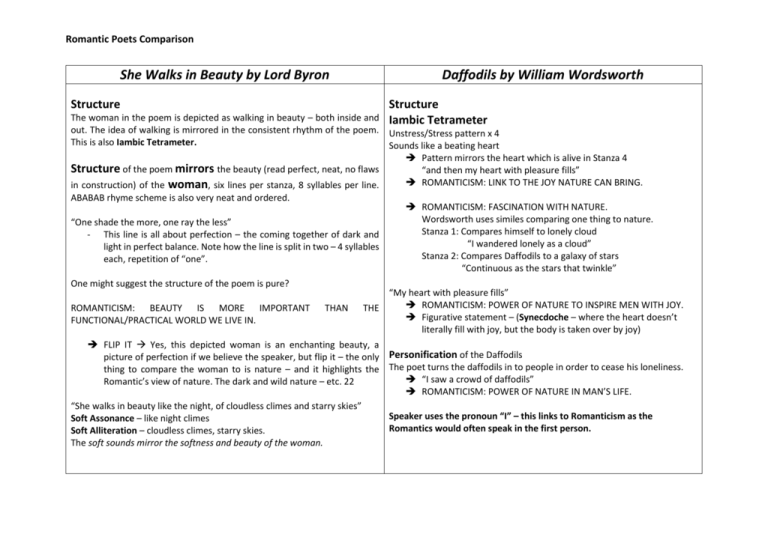
Romantic Poets Comparison She Walks in Beauty by Lord Byron Structure Daffodils by William Wordsworth Structure Iambic Tetrameter The woman in the poem is depicted as walking in beauty – both inside and out. The idea of walking is mirrored in the consistent rhythm of the poem. Unstress/Stress pattern x 4 This is also Iambic Tetrameter. Sounds like a beating heart Pattern mirrors the heart which is alive in Stanza 4 Structure of the poem mirrors the beauty (read perfect, neat, no flaws “and then my heart with pleasure fills” ROMANTICISM: LINK TO THE JOY NATURE CAN BRING. in construction) of the woman, six lines per stanza, 8 syllables per line. ABABAB rhyme scheme is also very neat and ordered. ROMANTICISM: FASCINATION WITH NATURE. Wordsworth uses similes comparing one thing to nature. “One shade the more, one ray the less” Stanza 1: Compares himself to lonely cloud - This line is all about perfection – the coming together of dark and “I wandered lonely as a cloud” light in perfect balance. Note how the line is split in two – 4 syllables Stanza 2: Compares Daffodils to a galaxy of stars each, repetition of “one”. “Continuous as the stars that twinkle” One might suggest the structure of the poem is pure? ROMANTICISM: BEAUTY IS MORE IMPORTANT FUNCTIONAL/PRACTICAL WORLD WE LIVE IN. THAN “My heart with pleasure fills” ROMANTICISM: POWER OF NATURE TO INSPIRE MEN WITH JOY. THE Figurative statement – (Synecdoche – where the heart doesn’t literally fill with joy, but the body is taken over by joy) FLIP IT Yes, this depicted woman is an enchanting beauty, a picture of perfection if we believe the speaker, but flip it – the only Personification of the Daffodils thing to compare the woman to is nature – and it highlights the The poet turns the daffodils in to people in order to cease his loneliness. “I saw a crowd of daffodils” Romantic’s view of nature. The dark and wild nature – etc. 22 ROMANTICISM: POWER OF NATURE IN MAN’S LIFE. “She walks in beauty like the night, of cloudless climes and starry skies” Speaker uses the pronoun “I” – this links to Romanticism as the Soft Assonance – like night climes Romantics would often speak in the first person. Soft Alliteration – cloudless climes, starry skies. The soft sounds mirror the softness and beauty of the woman. Romantic Poets Comparison Speaker uses simple language and simple subject matter to appeal to a wide audience. Romantics spoke to a common audience, as did the Romantics’ hero Shakespeare, who wrote “Shall I compare thee to a Summer’s day?” The audience can’t escape the reference as Byron compare’s thee to a night. This is called allusion – the alluding to or Shakespeare’s work. Similar to Wordsworth, this poem also uses simple language and subject. ROMANTICISM: A keen interest in innocence and purity – cities corrupted the land, buildings destroyed nature – see, purity in life is important. The woman is not just beautiful, but also pure. ROMANTICISM: Romantics liked to focus on emotional and physical passion – in this case, it may be the joy that the woman brings – but it does not move in to the physical. “All the best of dark and night” ROMANTICS HAD A FASCINATION WITH THE GOTHIC AND MYSTERY, WHICH THIS WOMAN SEEMS TO EXUDE. SIMILARLY, THEY WELCOME PURITY, INNOCENCE WHICH IS THE OTHER HALF OF THIS WOMAN. The whole poem is about nature and the joy it brings!!! “They flash upon that inward eye” - The remembering of the daffodils brings the speaker immense joy. ROMANTICISM: THE POWER AND IMPORTANCE OF THE IMAGINATION. DOES THE SPEAKER REMEMBER THE PAST TENSE EVENT, “I WANDERED” DIFFERENTLY IN THE PRESENT TENSE? DOES IT MATTER IF HIS MEMORY IS SKEWED? NO – BECAUSE HIS PRESENT TENSE JOY IS REAL AND COMFORTING.
